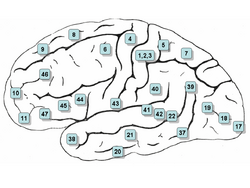
Image of brain with Brodmann areas numbered
Brodmann area 22 is one of Brodmann's cytologically defined regions of the brain. It is involved in auditory processing.
Human[]
Brodmann area 22 is a region of the human brain (the 22nd numbered Brodmann area). On the left side of the brain this area helps with generation and understanding of individual words. On the right side of the brain it helps tell the difference between melody, pitch, and sound intensity. Researchers believe this part of the brain is active in processing language.
This area is also known as superior temporal area 22, and it refers to a subdivision of the cytoarchitecturally defined temporal region of cerebral cortex. In the human it corresponds approximately to the lateral and caudal two thirds of the superior temporal gyrus. It is bounded rostrally by the temporopolar area 38 (H), medially by the posterior transverse temporal area 42 (H), ventrocaudally by the middle temporal area 21 and dorsocaudally by the supramarginal area 40 (H) and the angular area 39 (H) (Brodmann-1909).
The posterior section of Brodmann area 22 is home to Wernicke's area (most commonly in the left hemisphere only).
Guenon[]
Brodmann area 22 is a subdivision of the cerebral cortex of the guenon defined on the basis of cytoarchitecture. It is cytoarchitecturally homologous to the superior temporal area 22 of the human (Brodmann-1909). Distinctive features (Brodmann-1905): compared to Brodmann area 21-1909 the cortical thickness of area 22 is greater; cell density is reduced overall and the internal granular layer (IV) is even less developed with fewer cells; there is no detectable boundary between the internal pyramidal layer (V) and the multiform layer (VI); as in area 21, the ganglion cells of layer V are numerous and are arrayed adjacent to its boundary with layer IV, but they are plumper and more pyramidal in shape; the polymorphic cells of the multiform layer (VI) become gradually more numerous as one goes deeper and gives way to a wide sublayer 6b of fusiform cells as one approaches the boundary of the cortex with the subcortical white matter.
External links[]
- For Neuroanatomy of the superior temporal area 22 visit BrainInfo
- For Neuroanatomy of Brodmann area 22 visit BrainInfo